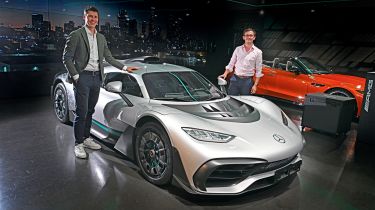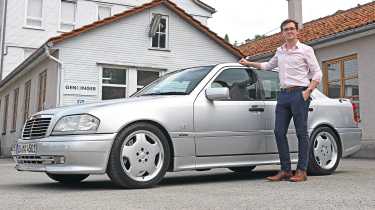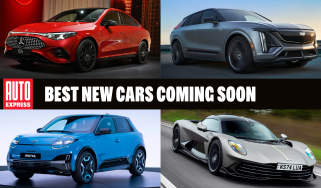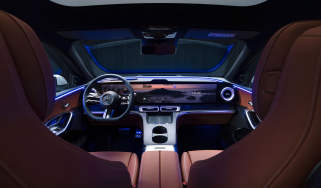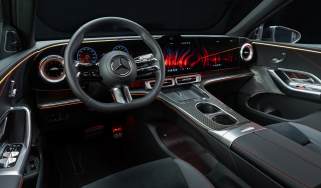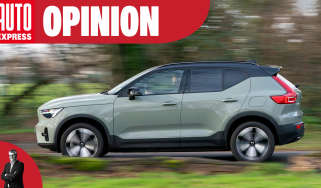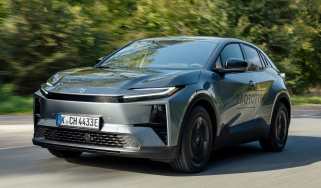What is Mercedes-AMG? Past, present and future of Mercedes' performance brand
From the ‘Red Pig’ to the AMG XX concept, we find out what makes Mercedes’ performance division tick on a visit to AMG’s headquarters in Affalterbach
For a manufacturer with a history that goes back to the very first motor car 140 years ago, it’s incredible to think that Mercedes choosing to buy a tuning firm that was started by two of its own employees in an old mill in rural eastern Germany could transform public perception of the brand in just over 25 years.
Nevertheless, AMG did what some deemed impossible, because it injected excitement into Mercedes which, at the time, was burdened with the image of being relatively old-fashioned and stuffy, despite its investment in technology – something the car maker continues to do today.
To really get to the core of what AMG represents and how its merger with Mercedes has brought a whole new audience and image for the brand, we visited AMG’s home at Affalterbach and also sat down with some of the company’s bigwigs to see what might be coming next.
If you’re interested in buying one of Mercedes-AMG's models, check out the Auto Express Buy A Car service. You can lease a car, buy a used car and sell your old car as well.
What does AMG stand for?
For those unaware, AMG actually stands for ‘Aufrecht, Melcher und Großaspach’ – the surnames of the company’s two founders, Hans Werner Aufrecht and Erhard Melcher, plus the name of a small village on the outskirts of Stuttgart where the pair first set up shop.
Where was AMG founded?
Contrary to popular belief, AMG wasn’t founded in Affalterbach, but instead in an old mill in Burgstall, near Affalterbach. Following the disaster at the 1955 Le Mans 24-hour race in which a car flew off the track and resulted in the deaths of 83 spectators, Mercedes decided to pull out of motor racing and focus on its road-car division.
This disappointed Mercedes workers Aufrecht and Melcher, so they decided to set up what was described at the time as an “engineering, design and testing office for the development of racing engines” in their spare time.
Aufrecht, a keen petrolhead and racing enthusiast, is quoted as saying that the AMG brand was born “out of a conviction for passion”. What may come as a surprise to some is that even though it’s now a subsidiary of the goliath that is Mercedes and employs more than 3,000 people, there remains a tenor of community spirit and genuine fervour for automotive perfection.
We sat down with Michael Schiebe – AMG’s CEO and the head of Merc’s Top End Vehicle (TEV) Group, which also includes the likes of Maybach – who told us: “The big difference with AMG [compared with Mercedes] is that it’s still a bit of rock n’ roll engineering; you have an idea – it might be crazy – but convince management and you’ll get the funding. The hierarchy is very flat.”
What was the first AMG car?
Following a few years of development, in true rock n’ roll fashion, AMG had the rather ludicrous idea of taking the colossal dreadnought of a luxury saloon car that was the 300 SEL racing. Only able to afford a damaged, used example, the team equipped the SEL with a monstrous 428bhp 6.8-litre V8 engine to accompany its executive leather interior, wool carpets and wooden dashboard.
Weighing in at more than 1,600kg, the so-called ‘Red Pig’ – named for its bright red livery, although the original car was actually black – first raised some eyebrows when it turned up to the 1971 24 Hours of Spa race in Belgium.
In fact, AMG’s archivist Daniela Sigl told us that AMG was almost sent away, with officials claiming it wasn’t a race car. After making it onto the grid, it’s rumoured the drivers even exaggerated the braking performance (or lack thereof) of the Red Pig, with other cars giving it a wide berth in the corners.
On the straights was where AMG’s creation really came into its own, something that suited the long stretches at Spa and helped the Red Pig to finish in a respectable second place, only two laps down on the leading Ford Capri. It might not have been the glorious win AMG was searching for, but it certainly turned some heads at Mercedes and was even featured on the national news in Germany, with excitement building that the car maker (albeit its unofficial skunkworks division) was back racing.
AMG is renowned for its powertrains, particularly its V8s and ‘One Man, One Engine’ philosophy – more on that later. However, it wasn’t until the mid-eighties, having moved to Affalterbach 10 years earlier, that AMG built its first bespoke engine: the 375bhp 6.0-litre, 32-valve ‘Hammer’ V8.
This was fitted to the W124 Mercedes 300 E, alongside lower, stiffer suspension, a Torsen limited-slip differential and a subtle yet impactful bodykit, transforming the sober and sensible E-Class into a bit of a hooligan. As Sigl said: “AMG found its rhythm in the eighties, offering what Mercedes couldn’t.”
That’s not to say Mercedes was incapable of producing a performance car; aside from its success in racing, the brand practically invented the supercar with the launch of the 300SL in the early sixties and also showed off its ability to build a strong sports saloon with the 190E Cosworth.
Nevertheless, Mercedes wisely saw how the slightly rebellious, performance-orientated AMG could help bolster its sales with enthusiasts, so it decided to partner with the company in 1990, allowing AMG models to be sold directly through Mercedes showrooms.
Just three years later and Mercedes’ first official collaboration with AMG was born with the arrival of the 280bhp Mercedes C 36. Now, such horsepower figures might appear modest today, but the C 36 really was a game-changer when it first arrived – this was in line with the BMW M3 at the time – and with Sigl, who owns one herself, at the wheel, the C 36 is tangibly more eager than a standard W202 C-Class. The smooth six-cylinder may not sound quite as ludicrous as the cars that came after it, yet it purrs beautifully and there’s still mountains of torque, despite the smaller displacement compared with the more contemporary V8s.
Affalterbach’s first fully bespoke model wouldn’t arrive until 2013, however, some 14 years after Mercedes fully absorbed the AMG brand in 1999. But it was well worth the wait, because it came in the form of the Mercedes SLS AMG, which was a modern reboot of the original 300 SL from the mid-fifties.
Driving any SLS is a pretty special occasion, however Mercedes was kind enough to toss us the keys to what is arguably the most sought-after version of the modern-classic supercar: the SLS Black Series.
Solarbeam Yellow paintwork glinting in the sun, the Mercedes SLS AMG Black Series takes everything that makes SLS iconic and turns it up to 11; the flared wheelarches make the Black look and feel like a GT3 car for the road. A 0-62mph time of 3.6 seconds is certainly fast by any measure, but in today’s world of sub-two-second electric Teslas, the hot SLS might seem a little all bark and no bite on paper.
Such a thing could not be further from the truth, however; the SLS Black gathers speed like a freight train, with the rolling thunder of the 6.2-litre naturally aspirated motor building to a crashing crescendo as you pass 6,500rpm. For such a large car, it changes direction with a focused urgency, too, although it’s ultimately something you have to treat with respect – give this car an inch and it could eat you alive.
AMG goes EV
It’s a common misconception that the Mercedes-AMG EQS 53 is AMG’s first electric car, but while it might be the first to hit full-scale production, it’s not the first EV Affalterbach developed. A zero-emissions version of the SLS called the SLS AMG Electric Drive was produced in very limited numbers in 2013, producing 740bhp from its four electric motors and able to cover up to 155 miles on a single charge.
Mercedes also furthered its exploration of electrified powertrains alongside its return to the pinnacle of motor racing. The Mercedes-AMG Petronas Formula One team dominated the sport like perhaps no other had before between 2014 and 2021. Behind the wheel of Mercedes-AMG’s hybrid-powered racers, Sir Lewis Hamilton and Nico Rosberg clinched eight World Drivers’ titles between them.
To celebrate its success in F1, Mercedes-AMG collaborated with Hamilton and the boffins at the team’s Brackley HQ in the UK to produce the firm’s first hypercar: the AMG One. Featuring the same 1.6-litre hybridised six-cylinder engine as in Merc’s F1 rocketship, the AMG One also gets trick aero, a seven-speed sequential gearbox and a full carbon-fibre body.
Yet regardless of how technically impressive the One is, with EVs being the next step in terms of electrification, Mercedes-AMG is now faced with the unenviable task of transferring the emotion and engagement of its petrol-powered models into the type of technology that years ago would have powered a milk float.
AMG CEO Schiebe explained how “sound is becoming more and more important as customers are not just buying cars because they accelerate fast – they are interested in a car that gives them emotions”. He added: “You’ll see we will have different trigger elements in this regard in our future series-production cars.”
What does he mean by this? Well, as we can see from the new AMG XX concept, which previews an upcoming four-door electric sports car from Affalterbach, Mercedes-AMG looks to be experimenting with augmented engine sounds that will emanate from the car’s headlights.
“It’s more than just sound AMG is playing with,” Scheibe said. “For example, when youstart the engine you can feel that there is something going on, that there is a huge engine with a lot of performance working under the car. We need to carry that on into the electric era.”
With this is mind, we can potentially expect AMG to integrate similar vibrations to that which you’d feel in a combustion car, plus potentially even simulated gearshifts like the Hyundai Ioniq 5 N. Although, as head of vehicle development, Steffen Jastrow told us: “We think we have a better solution than our competitors. Fun is important in a car, but so is performance and sometimes there is a fight between those two things – we will offer cars that have both.”
Will AMG bring back the V8?
Despite its recent push towards electrification, AMG hasn’t gone all in yet; there were outcries when the Mercedes-AMG C63 swapped its V8 for a capable, yet not all that characterful plug-in hybrid powertrain with a four-cylinder engine.
Of course, AMG does still sell V8 models; the Mercedes-AMG GT 63 flagship, for example, uses a mid-front-mounted 4.0-litre twin-turbo V8 with 577bhp going to all four wheels. From behind the wheel, this feels like a suitable evolution from the SLS; it’s much more usable everyday, even getting more than 25mpg on motorway trips and boasting a frankly cavernous boot.
The beating heart under the GT’s sweeping bonnet may have its vocals slightly stifled by particulate filters and turbos, but still has a gravelly rasp, giving the super-sports car an almost muscle car-like persona. Yet the quick and accurate steering, plus composed ride remind you you’re driving something much more sophisticated.
Schiebe admitted that “AMG’s main objective is serving our customers; if there are continuous demands for V8s, then producing them within regulations should be our engineering target”.
What does that mean? Well, the main crux of it is that AMG is not giving up on the bread and butter that is its V8 engines. During our time at Affalterbach, we saw the team at AMG working on its next generation of eight-cylinder motors.
Jastrow explained that the focus of this upcoming V8 unit was to improve both power and efficiency, stating that the team has “defined power in a range and the upper limit is, of course, higher than what we know today. There are also things you can do to improve the characteristics of the combustion engine, such as the response of the drive pedal”.
These V8 engines will continue to be built under AMG’s One Man, One Engine philosophy – or, should we say, ‘One Person, One Engine’, because Affalterbach’s powertrain department does employ one female engineer.
Such a concept gives AMG’s models a real bespoke feel and connects the customer to the builder of the machine itself. Yet while AMG manufactures its own electric powertrains, this is a much more ‘hands-off’ process, so with that in mind, how will the same spirit be kept alive?
“The personal relationship between the buyer and builder in the car is a signature element of AMG, so we’ll definitely continue with that into the electric era,” Schiebe explained. “There will definitely be something which is to do with craftsmanship and the attention someone pays to a specific car that won’t just be a marketing activity.”
Is this simply PR talk? Only time will tell, but it’s fair to say that AMG has quite the task ahead of it in keeping alive the sonorous sounds and deft dynamics that its vehicles are famous for.
Next year we’ll get our true first glimpse of what the future of AMG will look like when the covers are finally pulled off the production-ready AMG XX, complete with all of its so-called “trigger points”. Then and only then will we see if ‘rock n’ roll’ engineering’s transition from acoustic to electric will continue to strike a chord for driving enthusiasts.
What is Mercedes-AMG Black Series?
How to refocus the focused and high-performance? That was the quandary facing AMG in the mid-2000s when it launched its Design Studio with the aim of building low-production, track-focused versions of its existing line-up.
Thus the Black Series of cars were born, starting off with the SLK Black Series in 2007, followed by the CLK 63 Black Series that same year and the C 63 Black Series in 2011. Perhaps most ludicrous were the SL 65 Black Series and SLS Black Series; the former got a bespoke fixed-roof wide body and a V12 engine, while the SLS in essence acted as a road-going race car.
That hardcore Mercedes-AMG GT Black Series continued that notion in 2020. While the Mk3 AMG GT Black Series is yet to be fully revealed, AMG has teased a more extreme variant.
“We have had a huge success with Black Series models and everyone I speak to, their second question after ‘One Man, One Engine’ is about Black Series,” AMG boss Michael Schiebe said. “When we develop these cars, we always have to do something extraordinary and push the limits. I would just say be patient for a little while. It’s coming and you’ll learn more soon.”
Buy a car with Auto Express. Our nationwide dealer network has some fantastic cars on offer right now with new, used and leasing deals to choose from...
Find a car with the experts

